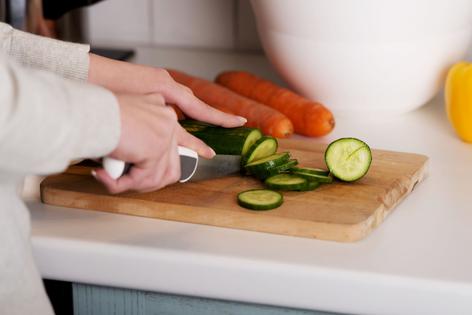Environmental Nutrition: Prepare fruits and vegetables wisely to preserve nutrients
Food preparation techniques such as peeling, chopping and cooking make an impact on the nutritional value of fruits and vegetables. Follow these tips to preserve nutrients in your kitchen.
Fresh is best, frozen is next. Fresh, ripe produce in-season -- with virtually no cooking required -- will usually be highest in nutrients. But what about produce in the middle of winter? U.S. Department of Agriculture data indicates that freezing produce immediately after harvesting retains 95 to 100 percent of most vitamins and minerals, with the exception of vitamin C, which diminishes by up to 30 percent in frozen produce.
Be water wise. USDA data shows that up to 50 percent of vitamin C, thiamin, vitamin B6 and folate content in food can be lost to the water it's cooked in. In order to retain water-soluble nutrients, use cooking methods like steaming or stir-frying that use less water, reduce water used in steaming and boiling, and reuse cooking water in soups or sauces to capture escaped nutrients.
Cut cooking times. As a rule of thumb, the longer foods are exposed to heat, the more nutrients are lost. To reduce cooking times, cover the pot to retain heat and avoid evaporation; place vegetables in already boiling water, and learn to enjoy vegetables with a crunchier texture.
Make friends with your microwave. Since it cuts cooking time and water use, the microwave is a nutrient-friendly kitchen appliance. A 2009 study published in the Journal of Food Science found microwaving preserved higher antioxidant activity in a majority of 20 vegetables studied compared to any other cooking method.
Chop less. Chopping foods into smaller pieces increases the surface area exposed to light, heat and water -- three factors that degrade nutrients. One exception is garlic and others in the allium family (onions, leeks, shallots.) Chopping these foods and allowing them to sit for 10 minutes before cooking increases their active components.
Preserve the peel. Keeping peels on foods like potatoes, yams and carrots preserves more nutrients that tend to concentrate just near the surface. In place of peeling, opt for a good vegetable brush and scrub vegetables thoroughly.
Use it all. Next time you are getting ready to throw away those beet or carrot tops, think again. Many vegetables are entirely edible and rich innutrients, so using the entire plant, from root to stem, is a sure way to add nutrients to your day.
Keep it cool. Nutrient loss in many fruits and vegetables can be decreased with cooler temperatures, high humidity, and less air contact. Store produce in airtight containers in the fridge.
Cooking helps, sometimes. Not all vegetables need to be eaten raw. In fact, cooking methods, such as baking, microwaving and stir-frying can increase the antioxidant activity of many vegetables, such as celery, carrots and green beans, according to a 2009 Journal of Food Science study.
No matter how we slice them, chop them, cook them--or not--simply eating more produce may be the best way to optimize nutrient intake. Nutrient synergy -- how the total sum of nutrients in a food interact with each other and respond to cooking methods -- helps explain why using a variety of cooking techniques and ingredients might be the best policy for optimizing the nutrient quality of your produce.
(Environmental Nutrition is the award-winning independent newsletter written by nutrition experts dedicated to providing readers up-to-date, accurate information about health and nutrition in clear, concise English. For more information, visit www.environmentalnutrition.com.)







